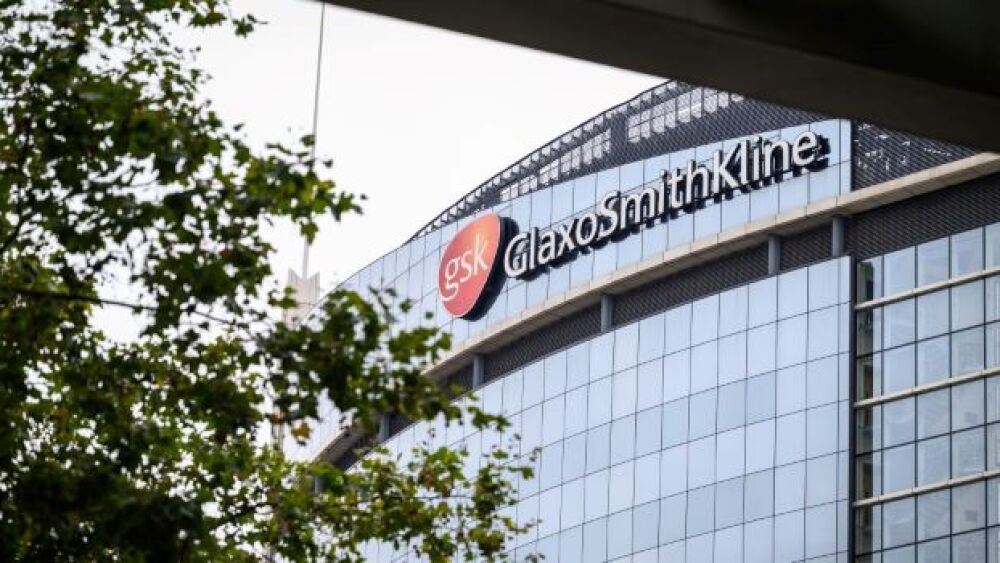GlaxoSmithKline exceeded expectations for its first-quarter sales and earnings forecasts. This was largely driven by its sales of Xevudy, an antibody treatment against COVID-19 it developed with Vir Biotechnology, and its Shingrix vaccine against shingles.
Leon Neal/Getty Images
GlaxoSmithKline exceeded expectations for its first-quarter sales and earnings forecasts. This was largely driven by its sales of Xevudy, an antibody treatment against COVID-19 it developed with Vir Biotechnology, and its Shingrix vaccine against shingles.
CEO Emma Walmsley said, “We have delivered strong first quarter results in this landmark year for GSK, as we separate Consumer Healthcare and start a new period of sustained growth. Our results reflect further good momentum across specialty medicines and vaccines, including the return to strong sales growth for Shingrix and continuing pipeline progress. We also continue to see very good momentum in Consumer Healthcare, demonstrating strong potential of this business ahead of its proposed demerger in July, to become Haleon.”
The company’s plans to spin out its consumer health division were announced in June 2021, which they will call Haleon, which comes from “Hale” for “in good health” and “Leon” for “strength.” Haleon is expected to rake in about $46 billion in annual sales by 2031 and generate consistent growth of more than 10% operating profit over the next five years. Meanwhile, its pharma business, the New GSK, will focus on vaccines and specialty therapeutics. Its four core therapeutic areas will be Infectious Diseases, HIV, Oncology and Immunology/Respiratory.
Haleon is a joint venture with Pfizer. The combined portfolio will include Advil, Tums, Sensodyne toothpaste, Excedrin and Nicorette gum, as well as Voltaren, Panadol and Centrum. It also includes the integration of consumer product portfolios from Novartis.
The rise of the Shingrix vaccine sales is believed to correlate with the waning of the COVID-19 pandemic. Walmsley said, “We’re seeing definite underlying demand return,” after seeing demand slow during the pandemic for adult immunizations in general. Shingrix alone brought in 698 million pounds ($875.86 million U.S.) in the quarter, exceeding analyst projections of 528 million pounds ($662.54 million U.S.).
“Key revenue driver Shingrix’s performance was encouraging … although recent data points to prescription levels still significantly below prepandemic volumes,” said Sebastian Skeet, an analyst with Third Bridge. “Longer term, mRNA vaccines pose a threat.”
Its Xevudy (sotrovimab) brought in 1.3 billion pounds ($1.6 billion U.S.) for the quarter, exceeding analyst expectations of 1.1 billion pounds ($1.38 billion U.S.). That’s good news overall, although recent data hints it probably isn’t as effective against the BA.2 subvariant, which is currently the dominant variant in the U.S. and is the top buyer therapy. U.S. regulators have pulled it off the market. However, Walmsley says the company is still in discussions with other governments where Xevudy is authorized.
GSK has not included Xevudy and other COVID-19-related products in its guidance for 2022. It projects underlying revenue growth of 5-7% and underlying operating profit to grow 12-14% for 2022.
Late last week, British GSK workers voted to strike against its recent pay raise. The workers, backed by British labor union Unite demanded a higher raise, arguing major inflating rates and the company’s recent financial successes. The company offered a 2.75% pay raise, then increased the offer to 4$, but the union and workers argue that even a 4% increase is a pay cut when considering inflation rates.
Around the same time, GSK and Germany’s CureVac reported promising preclinical data for their bivalent second-generation COVID-19 vaccine candidate. The vaccine combines two mRNAs encoding for the Beta and Delta variants. CureVac largely dropped its original mRNA vaccine attempts in 2021 after poor efficacy. The vaccine demonstrated only 47% efficacy in a Phase III trial.
In mid-2020, Tesla, Elon Musk’s electric car company, reported it was building mobile molecular printers to assist CureVac in manufacturing its experimental COVID-19 vaccine. The “printers” are portable, automated messenger RNA production units, what Musk called “RNA microfactories.” Otherwise, CureVac utilizes more traditional manufacturing facilities.
CureVac also had a run-in with then-President Donald Trump, when Trump was reported to have made a bid for the U.S. to acquire the company for an undisclosed “large sum” in order to have control of its COVID-19 vaccine. This prompted the German government to buy a 23% stake in the company of $358 million.
Although the first vaccine was something of a dud, earlier this month GSK and CureVac inked a contract with the German government to supply mRNA vaccines as part of a broader strategy for the country’s pandemic preparedness. The contract has a two-year implementation period, then Germany has access to CureVac’s manufacturing capacity until 2029, which could allow fast manufacture of 80 million mRNA-based vaccine doses. Once the preparation period is successfully completed, the German government will pay both companies an annual standby fee, which requires them to keep manufacturing capacity at constant readiness.





